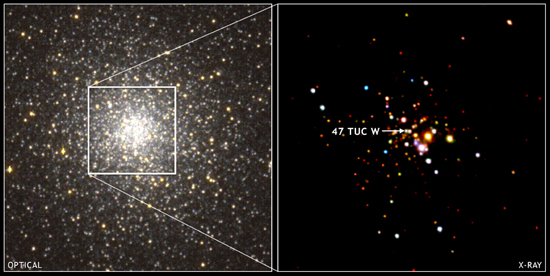47 Tuc W: A millisecond pulsar in the globular cluster 47 Tucanae
Caption: 47 Tuc W (denoted by arrow in the X-ray image) is a double, or binary star system consisting of a normal star and a pulsar. The pulsar rotates every 2.35 milliseconds. Blink your eye and a superdense neutron star the size of Manhattan Island will have rotated 25 or more times! Chandra's image shows about 20 millisecond pulsars in the globular cluster, but 47 Tuc W stands out from the crowd because it produces more high-energy X-rays than the others. This anomaly points to a different origin of the X-rays, namely a shock wave due to a collision between matter flowing from a companion star and particles racing away from the pulsar at near the speed of light. The observed similarity of 47 Tuc W to a well-studied X-ray binary system strongly suggests that millisecond pulsars evolve through the spinning up of neutron stars.
Scale: Left Panel: Image is 6.6 arcmin per side; Right panel: Image is 2.5 arcmin per side
Chandra X-ray Observatory ACIS Image
|


